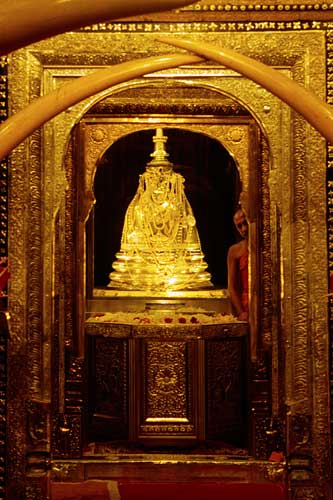Sri Dalada Maligawa, also known as the Temple of the Sacred Tooth Relic, is a Buddhist temple located in the city of Kandy, Sri Lanka. It is considered one of the most sacred Buddhist shrines in the world, as it houses the relic of the tooth of the Buddha. The temple is a UNESCO World Heritage Site and is an important place of pilgrimage for Buddhists from all over the world. The temple complex includes several buildings, including the main temple, the Audience Hall, and the Octagon. The temple is also known for its intricate carvings and beautiful frescoes. The temple is also the venue for the annual Esala Perahera festival which is a grand display of traditional dance and music, and is considered one of the most spectacular festivals in Sri Lanka.
Sri Dalada Maligawa is a complex of buildings that includes the main temple, the Audience Hall, the Octagon, and several other smaller shrines and buildings. The main temple is where the sacred tooth relic is kept and is considered the most sacred part of the complex. It is a two-storey building with a golden roof and is adorned with intricate carvings, sculptures, and frescoes. The Audience Hall, also known as the Maha Maligawa, is where the public can view the tooth relic during certain times of the year. The Octagon is a building that surrounds the main temple and is used for various rituals and ceremonies.
The temple is also known for its beautiful architecture and intricate carvings, which are a combination of Sinhalese, Indian, and Thai styles. The complex also houses a museum that displays various artifacts and treasures related to the tooth relic and Buddhism in Sri Lanka. The temple is an important pilgrimage site for Buddhists from all over the world, and especially for Sri Lankans. The temple also receives thousands of tourists every year who come to see the temple and learn about the history and culture of Sri Lanka.
The Esala Perahera festival is held annually in July or August, and is considered one of the most spectacular festivals in Sri Lanka. The festival is held in honor of the tooth relic and is a grand display of traditional dance, music, and elephant parades. The festival attracts thousands of visitors from all over the world, and is a must-see event for anyone visiting Sri Lanka during that time.


Sri Dalada Maligawa is considered one of the most sacred Buddhist shrines in the world. The temple is said to have been built in the 16th century by the King Wimaladharmasuriya I, and it has been an important place of pilgrimage for Buddhists ever since. The temple is also considered an important center of Buddhism in Sri Lanka, and it has played a significant role in the preservation and promotion of Buddhism in the country.
The temple is adorned with various carvings and sculptures, including the famous “Kandyan style” carvings, which are considered a masterpiece of Sri Lankan art. The temple also has a collection of valuable artifacts and treasures, including gold and silver plated items, and precious stones.
The temple is managed and maintained by the Diyawadana Nilame, who is the chief lay custodian of the temple, and the Malwatta Chapter, who are the chief monks of the temple. The temple is also protected and maintained by the government of Sri Lanka, which has declared it a UNESCO World Heritage Site.
The Esala Perahera festival is considered one of the most spectacular festivals in Sri Lanka. It is a ten-day festival that includes traditional dances, music, and elephant parades, and is held in honor of the sacred tooth relic. The festival is also a symbol of the unity and harmony between different religious and ethnic groups in Sri Lanka. Sri Dalada Maligawa is an important place of worship for Buddhists and a symbol of Sri Lanka’s rich cultural heritage and history. It is a must-see destination for anyone interested in Buddhism or Sri Lankan culture and history.
Sri Dalada Maligawa is not only an important religious site, it also holds immense cultural and historical significance. The temple has been a symbol of Sri Lanka’s rich cultural heritage and history for centuries. The temple complex is also home to several other shrines and buildings, including the Alut Maligawa, the Palace of the Tooth Relic, which was the residence of the Diyawadana Nilame, the chief lay custodian of the temple.
The temple is also closely associated with the royal family of Kandy, and was the center of the kingdom’s political and religious power during the Kandyan Kingdom. The tooth relic was also considered a symbol of the kingdom’s sovereignty and was used as a symbol of legitimacy for the Kandyan kings.
The temple also has a large collection of valuable artifacts and treasures, which include gold and silver plated items, precious stones and valuable manuscripts. These artifacts are an important part of Sri Lanka’s cultural heritage and are considered a valuable resource for the study of Buddhism and Sri Lankan history.
The temple also plays an important role in the preservation of traditional arts and crafts in Sri Lanka, particularly in the field of woodcarving and lacework. These traditional arts are closely associated with the temple, and are an important part of the temple’s cultural heritage.
The Esala Perahera festival is not only an important religious event, it is also a cultural event of great significance. It is an opportunity for people to come together to celebrate their cultural heritage and to promote unity and harmony among different religious and ethnic groups in Sri Lanka.
Sri Dalada Maligawa is an important cultural and historical site and a symbol of Sri Lanka’s rich heritage and history.
In addition to its religious, cultural, and historical significance, Sri Dalada Maligawa also plays an important role in the local economy. The temple is one of the most popular tourist destinations in Sri Lanka, and the Esala Perahera festival, in particular, attracts thousands of tourists from all over the world every year. This has led to the development of a significant tourism industry in Kandy and surrounding areas.
The temple also employs a large number of people, including priests, caretakers, and artisans, who are involved in the maintenance and management of the temple. These jobs are not only an important source of income for the local community but also help to preserve the traditional skills and crafts associated with the temple.
The temple also plays a role in the preservation of traditional knowledge and practices associated with Buddhism and Sri Lankan culture. The temple is home to a large number of Buddhist monks and scholars who are involved in the study and preservation of traditional Buddhist texts and practices.
Furthermore, Sri Dalada Maligawa is also known for its healing powers, it is believed that the relic has healing powers and people from all over the country come to the temple to seek blessings, and it’s said that many people have been cured of various illnesses after visiting the temple.
In conclusion, Sri Dalada Maligawa is not only an important religious, cultural, and historical site, but it also plays a significant role in the local economy and in the preservation of traditional knowledge and practices. It is a unique and valuable asset to Sri Lanka, not only as a religious and cultural site but also as a powerful symbol of unity, diversity, and common heritage for all Sri Lanka



